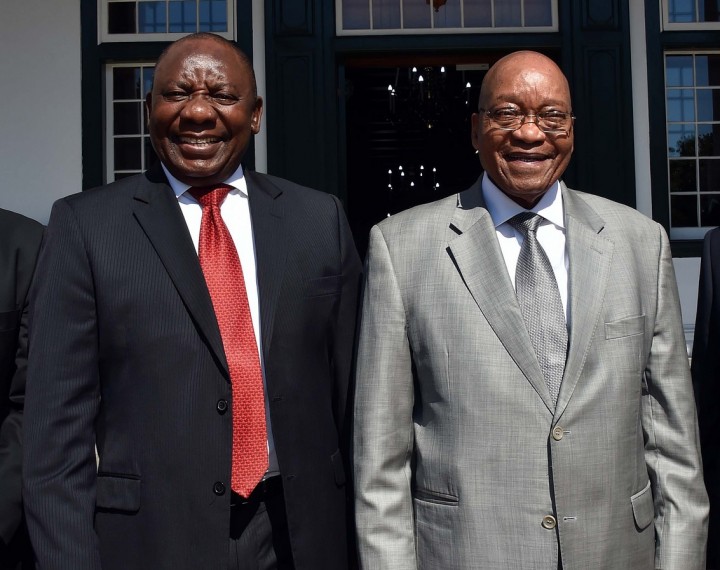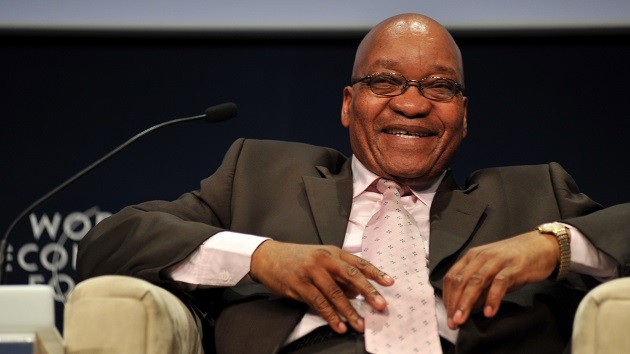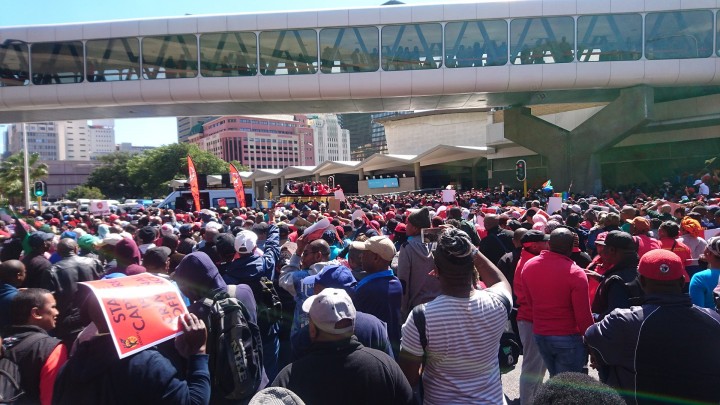Cyril Ramaphosa’s election as ANC president in December has coincided with the meltdown of the main bourgeois opposition party: the Democratic Alliance. But while the DA’s fortunes are declining, paradoxically, Ramaphosa’s victory at the Nasrec conference was widely welcomed by large sections of the ruling class, including big business that now feels more secure with one of its own at the helm of the ANC.
The markets were jubilant. The Rand recovered to its best levels since mid-2015. The stock exchange overcame the Steinhoff scandal to rally to new record highs at the prospect of a ‘market-friendly’ Ramaphosa presidency. The big business papers were elated. Business Day called it ‘a brighter outlook.’ Business confidence is up according to an index of the South African Chamber of Commerce and Industry. Ramaphosa himself declared ‘South Africa open for investment” in a major speech to celebrate the 106th anniversary of the founding of the ANC.
This contradiction between the DA’s decline and the markets’ reaction to Ramaphosa reflects the desperation of the ruling class. In reality the ‘Ramaphosa rally’ is a false dawn. It is more a case of relief than optimism for the future. Over the last decade the big bourgeoisie lost control of Zuma. He became the figurehead of the more openly corrupt junior wing of the ruling class. A victory for Zuma at the conference would have meant that big business had lost control of the ANC. But the victory of Ramaphosa has saved them from this prospect – for now!
It is not only the big capitalists who are relieved by Ramaphosa’s victory however. Large sections of the middle class, ravaged by the economic crisis particularly in the absence of a strong lead by the working class organisations, are forming illusions in Ramaphosa. In the period ahead, big business could lean on sections of the urban middle class and basing itself on some kind of anti-corruption drive, strike blows against elements of the Zuma wing. This is the meaning behind the dramatic purges we have seen over the last few days in state-owned companies like Eskom and the freezing of assets of the Gupta brothers.
 Jacob Zuma and Ramaphosa / Image: Government of South Africa
Jacob Zuma and Ramaphosa / Image: Government of South Africa
This is a serious struggle for Zuma and his backers and the stakes are high. We have seen in the December conference that although Ramaphosa won, the balance of forces is very even. So even if Ramaphosa succeeds in removing Zuma as president of the country, this will not be the end of the story. Zuma still has sizable support in the ANC. If his backers manage to mobilize their own base in the more backward rural provinces, the instability in the ANC could increase dramatically. This is therefore going to be a turbulent period and the widening cracks within the ruling class could open the way through which the masses can move.
Ramaphosa’s election as ANC president has not solved anything fundamental. The crisis of South African society is not a crisis of this or that individual, but a crisis of capitalism. Zuma’s departure will not solve this. Ramaphosa’s victory therefore merely raised the instability to a different level.There are still big events looming.
Zuma’s ticking time bomb
There are many triggers that could reignite the class struggle in South Africa. One of them is Zuma’s announcement just before the Nasrec conference in December to declare “free higher education” for households with a combined income of less than 350,000 Rand annually. He announced this without consulting anyone, including the Finance Minister, and without explaining how this will be funded. This was a demagogic move solely aimed at benefiting his faction ahead of the conference. In the end it had very little impact on the outcome with Ramaphosa walking away as party president.
 Jacob Zuma / Image: public domain
Jacob Zuma / Image: public domain
But now the Finance Minister, Malusi Gigaba, has the daunting task of finding nearly 13 billion Rand for his budget in February. This is for the first year alone. The budget already has a 51 billion Rand black hole. Thereafter he has to find between 15 billion and 50 billion Rand per year to sustain Zuma’s proposed scheme. And it is not going to get easier. Treasury estimates that the budget deficit will widen to 4.3 percent of GDP by 2018 and that the shortfall will grow rapidly to 209 billion Rand by 2019! On top of this, gross national debt is growing at an alarming pace. It is now projected to reach 61 percent of GDP by 2022, with repaying this debt being the single biggest cost to the budget. Already the government is spending twice the amount of money on servicing debt than on basic education. These projections does not include Zuma’s announcement!
Of course we fully support free higher education in South Africa. But who will finance it? It is clear that Zuma will not make the ruling class pay for it. Instead what we will see is further cuts and privatisations to finance the widening hole in public finances. The only way forward for the working class will be to fight to nationalise the mines, banks, financial companies and the big monopolies. This is the way to pay for the needs of the working class and the youth. On a capitalist basis there is no way forward.
The meltdown of the DA
Ramaphosa’s victory is bad news for the DA. Predominantly a liberal bourgeois party, the DA has sought to grow the party beyond its narrow base over the last two decades. But having absorbed large sections of the Afrikaner middle class after the demise of the National Party, the DA has begun reaching its peak.The nationalist agenda of the ANC and the absence of a working class alternative allowed the DA to win over a majority of the coloured working class in the Western Cape, allowing it to win the only province not governed by the ANC.
But in order to grow any further, the DA needed to make serious inroads into the black African vote. But this has caused friction in the party. In order to appeal to blacks, the DA adopted left-leaning language. This does not sit well with its core constituency.
The scandal-prone presidency of Zuma was a bonus to the DA. But now the imminent demise of Zuma together with the bourgeois liberals sowing illusions in Ramaphosa will mean that large sections of the urban African middle class, who were repelled by Zuma, could move back to the ANC in the next period. This is will mark a crisis in the DA, which is already showing signs of serious internal conflict.
Meanwhile the city of Cape Town, with a population of nearly four million people, could be the first major city to run out of water by April this year! The city has imposed severe water restrictions, including a 50-liter-per-person-per-day water ration on its residents. The DA city council blames the three-year-long drought in the catchment areas for this crisis. But the drought is a natural phenomenon and have always been part of the climate of this part of the country. The real reason for this calamitous state of affairs is the failure to plan by national, provincial and local government as well as the massive cuts the city has imposed on services over a period of 10 years.
The DA, which for years have boasted about “clean governance”, “unqualified audit reports” and running a “world-class” city is now openly panicking. In the midst of this looming disaster, massive infighting has erupted involving the mayor, Patricia de Lille and members of the executive council. This has now spread to the rest of the party. The infighting is so serious that it could lead to a split. It is true to say that at the beginning of 2018 the DA is experiencing a complete meltdown in its ranks.
The expectation that the city will run out of water by April is seriously worrying the government. There is widespread anger and panic among ordinary people in the region. In order to deal with the water crisis the city is making deep cuts in other areas. This is inflaming the situation even more. Mass protests and demonstrations are now regular features in the poorer areas. The situation could have a devastating effect on the economy of the city and in the province, particularly if many businesses relocate or close down. As the crisis deepens, it could therefore spread to the big working class areas. With this in mind there are suggestions of declaring a state of emergency and deploying the army throughout the metro to deal with the fallout. This means that the government is expecting civil unrest.
The DA is deeply divided across the country. But its problems run deeper in its flagship of Cape Town and in the Western Cape. The water crisis is only the tip of the iceberg. In reality Cape Town is a city with two faces. On the one hand, it is a playground for the rich and a paradise for tourists. According to a poll of 90,000 tourists for the 2017 Telegraph Travel Awards, British tourists rank it “the best city in the world”: ahead of Vancouver and Tokyo. On the other it is a nightmare for the poor black and coloured majority. The social, political and economic contradictions is more stark in Cape Town than in any other South African city. A State of South African Cities Report released in 2016 states that Cape Town is the only city in South Africa where the proportion of people living in informal areas has increased over the past five years. The water crisis could be the spark to set off the powder keg.
A return to the industrial front
After the massive increase in strikes between 2009 and 2013 the workers have moved to the political front for the last four years. At the end of 2013 there were big expectations for the formation of a workers’ party after the NUMSA special congress. But now four years later, and despite another congress adopting yet another resolution calling for such a party, there is still no sign of this.
This is putting obstacles in the path of the workers. In the wake of this there are signs that the workers struggles could return to the industrial front. The current public sector wage negotiations at the Public Service Coordinating Bargaining Council are very acrimonious.“We do recognise that the compensation of employees raises a fiscal risk”, said Finance Minister Malusi Gigaba in his medium-term budget in October.
In a joint statement the public sector unions said that the government negotiated in bad faith: “We are not averse to confrontation if provoked‚ and if they continue on this path‚ the pushback will be ferocious and ugly. Difficult or hostile negotiations will not serve anyone‚ let alone the economy – so they must stop negotiating in bad faith‚” the statement said. This militant stance reflects the pressures that is accumulating from within the ranks of the working class.
The government is offering a 5.3 percent wage increase. The unions have called it “ridiculous” and demand between 10 and 12 percent. If the talks are not concluded by the 31 March deadline, government workers could go on strike. In 2010 more than 1.3 million public sector workers went on a three-week strike. If talks do not reach an agreement, there is a possibility of hundreds of thousands of public sector workers walking off the job again.
In addition to the public sector, there are also major struggles ahead in the industries. The big telecoms company, Telkom, has indicated that it may not be able to grant an increase and a strike is therefore a real possibility. There could also be industrial action in the giant electricity company, Eskom, steel giant ArcelorMittal, at the giant petrochemical company Sasol and in the gold mining industry.
 COSATU protest in Cape Town / Image: Discott
COSATU protest in Cape Town / Image: Discott
In addition to the looming industrial action, the unions also have to fight the most draconian proposed amendments to the labour laws since they were adopted in 1995. These changes to the labour laws, if adopted by parliament, will mark a direct attack on the working class.Two of the proposed changes will affect workers’ right to strike including requiring for unions to hold secret ballots and another for the creation of an “advisory arbitration panel” which employers could use instead of dealing with workers directly.
Scandalously, the class collaboration leaders of the COSATU and Fedusa federations have been involved in these talks and have put up very mild resistance. NUMSA, on the other hand, has correctly come out against this, stating: “these changes are an attack on the working class and their families because they reduce the hard won rights which workers fought and died for under apartheid.” They also rejected the provision in the amendment giving the Minister of the Labour the power to get a court interdict to suspend lengthy and protracted strikes. NUMSA issued an appeal to “all working class formations and structures” to “reject and fight this assault on the working class”.
The union warned of mass action: “The struggle for a dignified living wage, and the battle to defend our rights will not be won in public hearings. It will be won by the working class in action, on the streets, united in its demands,” it said.
This is the correct line and has to be carried into action. The new labour federation, SAFTU, will be severely tested in this upcoming battle. A determined struggle could win over large sections of the working class.
All of this indicates that big battles lie ahead. The working class is undefeated and the balance of forces is heavily in its favour. In a country where three men have more wealth than the bottom half of the county, where the top 10 percent capture 66 percent of the national income, and where the top 1 percent hold 20 percent of the wealth, it is no wonder that the political situation is so explosive. In the next period these contradictions will lead to an intensification of the class struggle and the moving of the working class towards a revolutionary basis. On a capitalist basis there is no way forward. Only with the overthrow of the system and the introduction of a workers’ state with a nationalised planned economy can the basic problems of the working class begin to be addressed.
